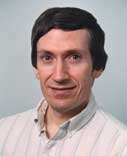John Stembridge, a professor of mathematics, is a member of an international team of 18 mathematicians and computer scientists who successfully have mapped the Lie group E8, one of the largest and most complicated structures in mathematics. The findings will be unveiled today (March 19) at a presentation by David Vogan, professor of mathematics at MIT and member of the team.

The magnitude of the E8 calculation is being compared to Human Genome Project, and is so large it would cover Manhattan if it were written out on paper, according to the American Institute of Mathematics (AIM), one of the leading math institutes in the country.
E8 is an example of a Lie (pronounced “Lee”) group. Lie groups were invented by the 19th century Norwegian mathematician Sophus Lie to study symmetry. Underlying any symmetrical object, such as a sphere, is a Lie group. Balls, cylinders or cones are familiar examples of symmetric three-dimensional objects. Mathematicians study symmetries in higher dimensions. In fact, E8 is the group of symmetries of a geometric object like a sphere, cylinder or cone, but the object in this case is 57-dimensional. E8 itself is 248-dimensional. For details on E8 visit aimath.org/E8/.
“E8 was discovered over a century ago, in 1887, and until now, no one thought the structure could ever be understood,” says Jeffrey Adams, project leader and mathematics professor at the University of Maryland. “This groundbreaking achievement is significant both as an advance in basic knowledge, as well as a major advance in the use of large scale computing to solve complicated mathematical problems. The mapping of E8 may well have unforeseen implications in mathematics and physics which won’t be evident for years to come.
“We’ve determined the basic building blocks that are needed to understand how E8 is represented in nature,” says Stembridge, one of the co-principal investigators. “This could lead to better understanding of the physical models of the universe.”
Stembridge says the way the calculation was achieved by a group of 18 mathematicians and computer scientists working in intensive collaboration for four years also is a significant breakthrough. Partners on this project also include MIT, Cornell University, the University of Utah and University of Maryland.
“Mathematicians more typically work in groups of one, two or three,” Stembridge says. “We have a large group spread all over the U.S. and in France. That is unusual.”
Stembridge says the mapping of E8 also will create opportunities for students at U-M. “Students might get to work on a cool problem as part of this project.”
The magnitude and nature of the E8 calculation invites the comparison with the Human Genome Project, according to AIM. The human genome, which contains all the genetic information of a cell, is less than a gigabyte in size. The result of the E8 calculation, which contains all the information about E8 and its representations, is 60 gigabytes. This is enough to store 45 days of continuous music in MP3 format.
The computation required sophisticated new mathematical techniques and computing power not available even a few years ago. While many scientific projects involve processing large amounts of data, the E8 calculation is very different, as the size of the input is comparatively small, but the answer itself is enormous and very dense.
The E8 calculation is part of an ambitious project sponsored by AIM and the National Science Foundation, known as the Atlas of Lie Groups and Representations. The goal of the project is to determine the unitary representations of all the Lie groups (E8 is the largest of the exceptional Lie groups). This is one of the most important unsolved problems of mathematics. The E8 calculation is a major step, and signals that the Atlas team is well on the way to solving the problem, mathematicians say.
“This is an impressive achievement,” says Hermann Nicolai, director of the Albert Einstein Institute in Potsdam, Germany. “While mathematicians have known for a long time about the beauty and the uniqueness of E8, we physicists have come to appreciate its exceptional role only more recently. Understanding the inner workings of E8 is not only a great advance for pure mathematics, but may also help physicists in their quest for a unified theory.”

